

|
|
Standing at 111 meters tall, around the height of a 36-story-building and nearly 18 m taller than the Statue of Liberty, the Apollo/Saturn V, pronounced 'Saturn Five' vehicle was a heavy lift rocket that was at the time (1960's through the 1970s) the most powerful ever to successfully take flight.
Not only would this incredible example of human engineering carry men to the moon, but it would also help launch Skylab, the first space station launched by the U.S. into low-earth orbit.
The Saturn V is considered to this day to be one of the safest and most successful launch systems ever created, with 13 launches, including 10 with people, without any serious problems.
The design of the Saturn V was overseen by German-American aerospace engineer Werner Von Braun as he served as director of NASA's Marshall Space Flight Center in Huntsville.
The Saturn V weighed a staggering 2.8 million kilograms - about equivalent to a herd of 400 elephants - when fully fueled, with the first stage alone holding 770,000 liters of kerosene fuel and 1.2 million liters of liquid oxygen.
To get the Apollo spacecraft payload of the Saturn V into orbit and to the moon, the engines of the first two stages of the rocket used liquid fuel and oxygen to blast off with 3.4 million kg of thrust. This has only recently been surpassed by the Starship/SuperHeavy launch system, whose 33 Raptor engines will generate more than 7.3 million kg of thrust, roughly twice that of the Saturn 5.
The engines of the Saturn V could carry a payload weighing as much as 118 tonnes into orbit around the Earth. The rocket with its various stages was also capable of delivering 45 tonnes to the surface of the moon, the equivalent of four school buses.
Here are some specs comparing the Space Shuttle to the Apollo/Saturn vehicle:
Space Shuttle
Payload: 27,500 kg to low-Earth orbit
Height 55 m
Weight 2.1 million kg
Lift off thrust 3.5 million kg
Flew 135 times between 1981 and 2011
Saturn V
Payload: 118,000 kg to low-Earth orbit
45,000 kg to the moon
Height 110.6 m
Weight 2.9 million kg
Lift off thrust 3.4 million kg
Flew 13 times between 1967 and 1973
|
Here's a comparison of the height of the Saturn V to other large rockets:
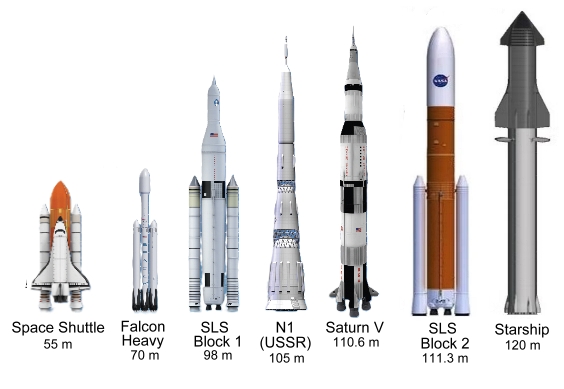
The Vehicle Assembly Building was built especially to allow the various stages of the rocket to be assembled vertically. It was also used to assemble the Space Shuttle, and remains for use with future launch systems.
The structure is the world’s fourth largest building by volume, and the largest one-story building in the world. It's 160 metres tall, and with a volume of 3,665,000 cubic meters, it has an interior volume roughly about 3.75 times that of the Empire State Building. It's so large, in fact, that it has its own weather. On humid days, rain clouds can form below the ceiling, requiring about 10,000 tons of air conditioning equipment to control the moisture. The doors on the building, which are the largest in the world, are tall enough to easily fit the Statue of Liberty, and take 45 minutes to open or close.
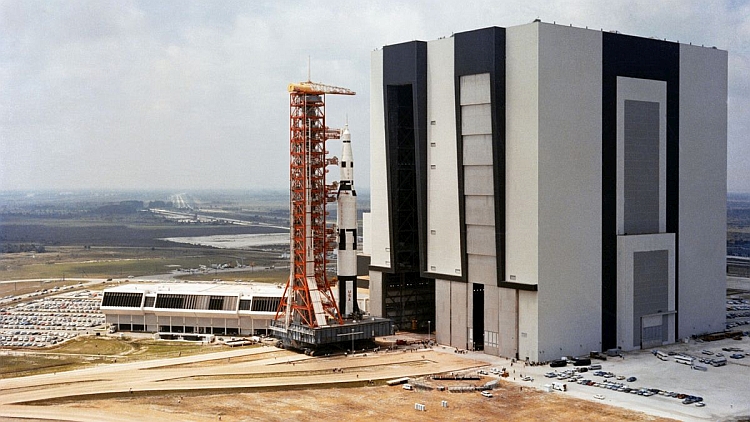
The Crawler-Transporters were vehicles built for the sole purpose of moving the completed Apollo/Saturn rocket from the Vehicle Assembly Building to the launch pad, a distance of 6.7 kilometres. They were also used for the same purpose with the Space Shuttles, and will continue to be used with future rocket systems.
Each is powered by locomotive and large electrical power generator engines, and was designed to travel at just over 3 kilometres per hour
unloaded. Because the launch
pads are built on sloping pyramids, the crawler uses
its hydraulic suspension to keep the platform level all
the way to the top of the pad, where it sets the platform in place
so the rocket can lift off safely.
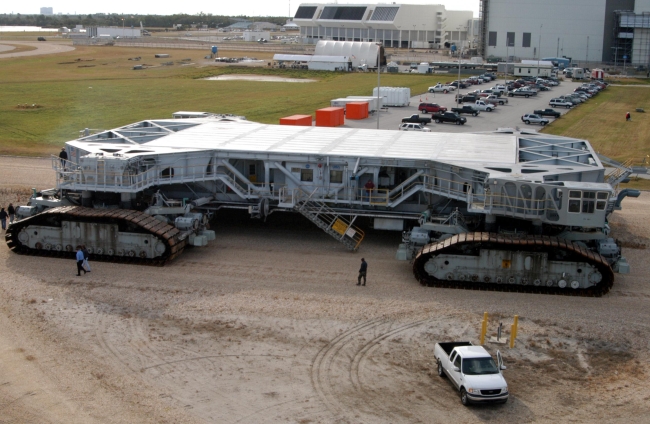
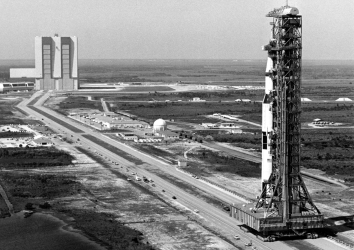 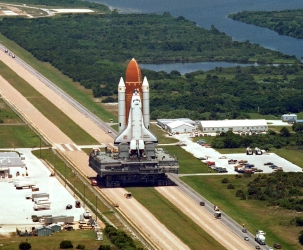
The Saturn V's most powerful engines were on its first stage; this was the stage of the rocket that had to lift the tremendous mass of a fully fueled rocket away from Earth.
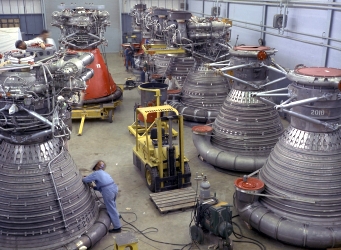
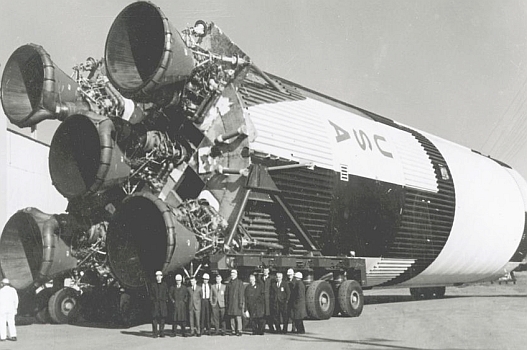
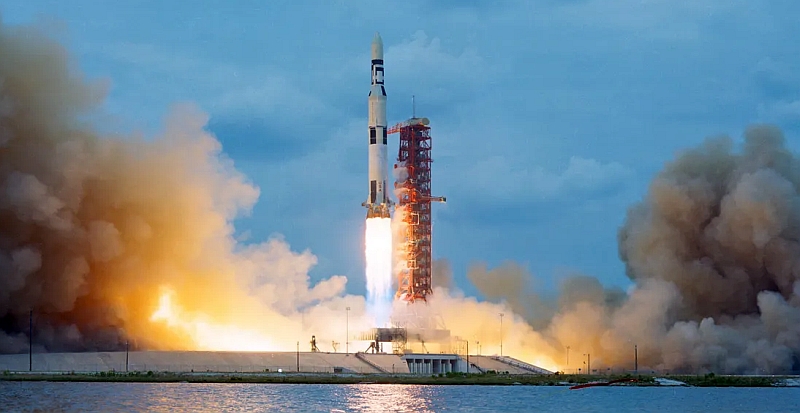
The Apollo mission consisted of a Command/Service Module and a two-part Lunar Module. The Command/Service Module and Lunar Module would separate after achieving lunar orbit insertion, with two of the astronauts in the Lunar Module. They would descend to the lunar surface using the engine in the lower descent stage of the Lunar Module. After exploring the surface, the astronauts would fire the ascent engine in the top half of the Lunar Module, which would separate, leaving the lower half on the surface while the top half ascended to orbit to rendezvous with the Command/Service Module for the journey back to Earth.
Apollo/Saturn Mission Profile
- Launch. First and second stages fire, and then jettisoned. Third stage fires
- Earth orbit achieved. Spacecraft speed 28,000 km/h
- Third stage fires again to propel payload spacecraft toward moon. Spacecraft speed 40,000 km/h
- Canopy on third stage opens. Command/Service Module exits
- Command/Service Module turns and removes Lunar Module
- Third stage discarded
- Command/Service Module with Lunar Module attached continues to moon
- Service Module SPS engine burns to insert craft into lunar orbit
- Lunar Module with two of the three astronauts separates, and descends to moon's surface using lower stage motor. One astronaut remains orbiting the moon in Command Module
- Surface activities
- Lunar Module top half lifts off using upper stage motor; rendezvous with Command Module in orbit
- Lunar Module discarded
- Command/Service Module SPS engine burns again to leave lunar orbit
- Near Earth, Service Module discarded
- Command Module enters atmosphere, lands in ocean on 3 parachutes
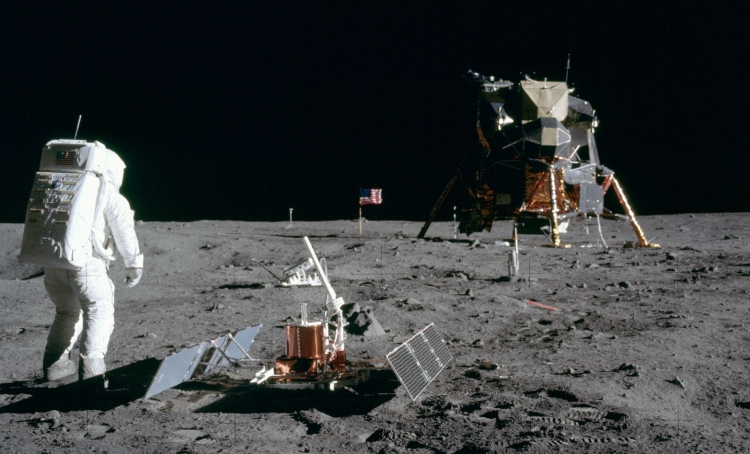
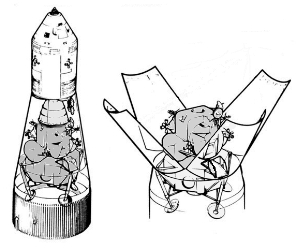
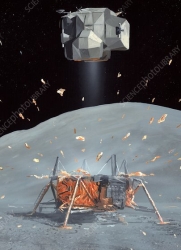
Above: Lunar Module inside 3rd stage canopy; Upper stage of Lunar Module lift-off [See a video]
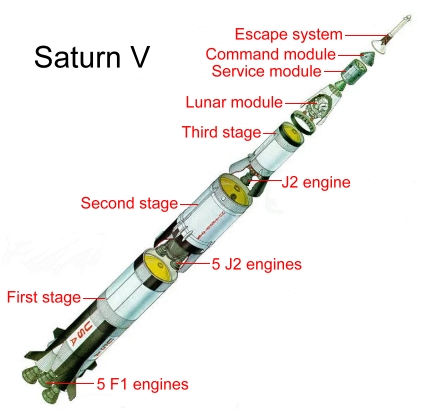
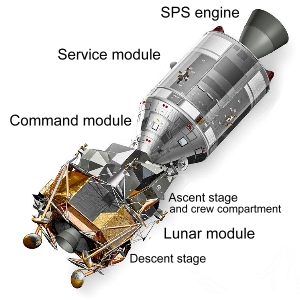
The Saturn/Apollo Flights
Apollo 4
Launched 9 November 1967
First all-up launch of Saturn V
Apollo 5
Launched 22 January 1968
First test of Lunar Module in space
Apollo 6
Launched 4 April 1968
Final uncrewed Apollo test flight
Apollo Crewed Missions
Apollo 7
Launched 11 October 1968
First crewed Apollo flight in Earth orbit
Apollo 9
Launched 03 March 1969
First crewed Lunar Module test in Earth orbit
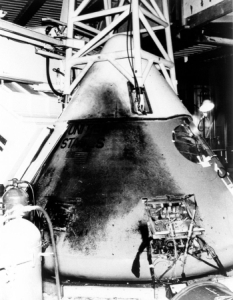
The Command Module of Apollo 1. Meant to be the first sub-orbital flight of Apollo, three astronauts Gus Grissom Roger Chaffee and Ed White were killed on February 21, 1967 while sitting on the launch pad conducting tests, when a fire broke out inside the closed Command Module.
The pure oxygen air supply, flammable materials, and a difficult-to-open hatch were all to blame.
|
|
Apollo Lunar Missions
Apollo 8
Launched 21 December 1968
Lunar Orbit and Return
Apollo 10
Launched 18 May 1969
Low Lunar Orbit and Return
Apollo 11
Launched 16 July 1969
Landed on Moon 20 July 1969
Sea of Tranquility
Apollo 12
Launched 14 November 1969
Landed on Moon 19 November 1969
Ocean of Storms
Apollo 13
Launched 11 April 1970
Lunar Flyby and Return
Malfunction forced cancellation of lunar landing
Apollo 14
Launched 31 January 1971
Landed on Moon 5 February 1971
Fra Mauro
Apollo 15
Launched 26 July 1971
Landed on Moon 30 July 1971
Hadley Rille
Apollo 16
Launched 16 April 1972
Landed on Moon 20 April 1972
Descartes
Apollo 17
Launched 07 December 1972
Landed on Moon 11 December 1972
Taurus-Littrow
|
The remarkable thing about the Apollo/Saturn spacecraft and booster was that it worked so well! There were so many parts and stages to the mission, each of which had to succeed flawlessly! All of the practice for the lunar missions took place over the space of just a mere eight years, from 1961 through 1969, with six one-manned Mercury flights, ten Gemini 2-man crewed missions, and two Earth-orbit 3-man Apollo missions.
The only in-flight problem to occur, on Apollo 13, was caused by a spark from a tiny, faulty switch inside an oxygen tank when it was being stirred, which caused the tank to explode, putting the Service Module out of commission.
Resources
Content, HTML & design by Bill Willis 2023
|















